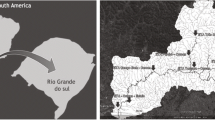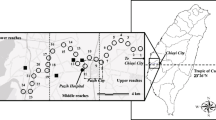Abstract
The aim of this study was to determine the origin (human, bovine or porcine) and the concentration of the fecal sources of contamination in waters from Santa Lucía basin and Uruguay River in Uruguay by using host-specific viral markers (adenoviruses and polyomaviruses) as microbial source tracking (MST). Between June 2015 and May 2016, monthly collections of surface water samples were performed in six sites in Santa Lucía basin and four sites in Uruguay River (n = 120 samples). Viral concentration was carried out using an absorption-elution method. Detection and quantification of human and porcine adenovirus (HAdV and PAdV, respectively) and human and bovine polyomavirus (HPyV and BoPyV, respectively) were performed by quantitative PCR (qPCR). To evaluate the infectivity of circulating HAdV, an integrated cell culture-qPCR (ICC-qPCR) was used. A logistic regression analysis was carried out to estimate the influence of environmental variables on the virus presence in surface waters. Overall, HAdV was the prevalent (18%; 21/120) followed by BoPyV (11%; 13/120) and HPyV (3%; 3/120), whereas PAdV was not detected in this study. The mean concentration ranged from 1.5 × 104 genomic copies/L (gc/L) for HAdV to 1.8 × 102 gc/L for HPyV. Infective HAdVs were observed in two out of ten analyzed samples. A significant effect of environmental temperature (p = 0.001) and river (p = 0.012) on the presence of human viruses was found. These results suggest that fecal contamination could affect the water quality of these rivers, showing deficiencies in the procedure of sewage discharge from regional cities, livestock and dairy farms.



Similar content being viewed by others
References
Allard, A., Albinsson, B., & Wadell, G. (2001). Rapid typing of human adenoviruses by a general PCR combined with restriction endonuclease analysis. Journal of Clinical Microbiology, 39(2), 498–505.
Barreto, P., Dogliotti, S., & Perdomo, C. (2017). Surface water quality of intensive farming areas within the santa lucia river basin of Uruguay. Air, Soil and Water Research, 10, 1178622117715446.
Berk, (2013). Adenoviridae. In D. M. Knipe & P. M. Howley (Eds.), Fields virology (6th ed., pp. 1704–1731). Philadelphia: Lippincott Williams and Wilkins.
Bertrand, I., Schijven, J., Sanchez, G., Wyn-Jones, P., Ottoson, J., Morin, T., et al. (2012). The impact of temperature on the inactivation of enteric viruses in food and water: a review. Journal of Applied Microbiology, 112, 1059–1074.
Bofill-Mas, S., Rusiñol, M., Fernandez-Cassi, X., Carratalà, A., Hundesa, A., & Girones, R. (2013). Quantification of human and animal viruses to differentiate the origin of the fecal contamination present in environmental samples. Biomedical Research International., 2013, 192089.
Bosch, A., Guix, S., Sano, D., & Pintó, R. M. (2008). New tools for the study and direct surveillance of viral pathogens in water. Current Opinion in Biotechnology, 19(3), 295–301.
Carratalá, A., Rodriguez-Manzano, J., Hundesa, A., Rusiñol, M., Fresno, S., Cook, N., et al. (2013). Effect of temperature and sunlight on the stability of human adenoviruses and MS2 as fecal contaminants on fresh produce surfaces. International Journal of Food Microbiology, 164(2–3), 128–134.
C.A.R.U. Comisión Administradora del Río Uruguay. (2018). El Río Uruguay en cifras. Retrieved December 3, 2018, from http://www.caru.org.uy/web/acerca-de/prueba-pagina.
Celik, C., Gozel, M. G., Turkay, H., Bakici, M. Z., Güven, A. S., & Elaldi, N. (2015). Rotavirus and Adenovirus gastroenteritis: time series analysis. Pediatrics International, 57(4), 590–596.
Chan, M. C., Sung, J. J., Lam, R. K., Chan, P. K., Lee, N. L., Lai, R. W., et al. (2006). Fecal viral load and norovirus-associated gastroenteritis. Emerging Infectious Diseases, 12(8), 1278–1280.
Corsi, S. R., Borchardt, M. A., Spencer, S. K., Hughes, P. E., & Baldwin, A. K. (2014). Human and bovine viruses in the Milwaukee River watershed: hydrologically relevant representation and relations with environmental variables. Science of the Total Environment, 490, 849–860.
Cromeans, T. L., Lu, X., Erdman, D. D., Humphrey, C. D., & Hill, V. R. (2008). Development of plaque assays for adenoviruses 40 and 41. Journal of Virological Methods, 151(1), 140–145.
De Caprio, (2013). Polyomaviridae. In D. M. Knipe & P. M. Howley (Eds.), Fields virology (6th ed., pp. 1633–1661). Philadelphia: Lippincott Williams and Wilkins.
Edgard, R. C. (2004). MUSCLE: multiple sequence alignment with high accuracy and high throughput. Nucleic Acids Research, 32(5), 1792–1795.
Farkas, K., Cooper, D. M., McDonald, J. E., Malham, S. K., de Rougemont, A., & Jones, D. L. (2018). Seasonal and spatial dynamics of enteric viruses in wastewater and in riverine and estuarine receiving waters. Science of the Total Environment, 634, 1174–1183.
Fongaro, G., Nascimento, M. A., Rigotto, C., Ritterbusch, G., da Silva, A. D., Esteves, P. A., et al. (2013). Evaluation and molecular characterization of human adenovirus in drinking water supplies: viral integrity and viability assays. Virol J, 10, 166.
Girones, R., Ferrús, M. A., Alonso, J. L., Rodriguez-Manzano, J., Calgua, B., Corrêa, A. A., et al. (2010). Molecular detection of pathogens in water—The pros and cons of molecular techniques. Water Research, 44, 4325–4339.
Haramoto, E., Katayama, H., Utagawa, E., & Ohgaki, S. (2009). Recovery of human norovirus from water by virus concentration methods. Journal of Virological Methods, 160(1–2), 206–209.
Hernroth, B. E., Conden-Hansson, A. C., Rehnstam-Holm, A. S., Girones, R., & Allard, A. K. (2002). Environmental factors influencing human viral pathogens and their potential indicator organisms in the blue mussel, Mytilus edulis: the first Scandinavian report. Applied and Environment Microbiology, 68(9), 4523–4533.
Hundesa, A., Bofill-Mas, S., Maluquer de Motes, C., Rodriguez-Manzano, J., Bach, A., Casas, M., et al. (2010). Development of a quantitative PCR assay for the quantitation of bovine polyomavirus as a microbial source-tracking tool. Journal of Virological Methods, 163(2), 385–389.
Hundesa, A., Maluquer de Motes, C., Albinana-Gimenez, N., Rodriguez-Manzano, J., Bofill-Mas, S., Suñen, E., et al. (2009). Development of a qPCR assay for the quantification of porcine adenoviruses as an MST tool for swine fecal contamination in the environment. Journal of Virological Methods, 158(1–2), 130–135.
Jiang, S. C. (2006). Human adenoviruses in water: occurrence and health implications: a critical review. Environmental Science and Technology, 40, 7132–7140.
Katayama, H., Shimasaki, A., & Ohgaki, S. (2002). Development of a virus concentration method and its application to detection of enterovirus and Norwalk virus from coastal seawater. Applied and Environment Microbiology, 68(3), 1033–1039.
Kumar, S., Stecher, G., & Tamura, K. (2016). MEGA7: Molecular evolutionary genetics analysis version 7.0 for bigger datasets. Mol Biol Evol., 33(7), 1870–1874.
McQuaig, S., Griffith, J., & Harwood, V. J. (2012). Association of fecal indicator bacteria with human viruses and microbial source tracking markers at coastal beaches impacted by nonpoint source pollution. Applied and Environment Microbiology, 78(18), 6423–6432.
Mena, K. D., & Gerba, C. P. (2009). Waterborne adenovirus. Reviews of Environmental Contamination and Toxicology, 198, 133–167.
MGAP, DIEA. (2018). Retrieved 28, November, 2018, from http://www.mgap.gub.uy/unidad-organizativa/oficina-de-programacion-y-politicas-agropecuarias/publicaciones/anuarios-diea/anuarioestad%C3%ADstico-de-diea-2017.
Pal, A., Sirota, L., Maudru, T., Peden, K., & Lewis, A. M. (2006). Real-time, quantitative PCR assays for the detection of virus-specific DNA in samples with mixed populations of polyomaviruses. Journal of Virological Methods, 135(1), 32–42.
Reynolds, K. A. (2004). Integrated cell culture/PCR for detection of enteric viruses in environmental samples. Methods in Molecular Biology, 268, 69–78.
Rigotto, C., Sincero, T. C. M., Simoes, C. M. O., & Barardi, C. R. M. (2005). Detection of adenoviruses in shellfish by means of conventional-PCR, nested-PCR, and integrated cell culture PCR (ICC/PCR). Water Research, 39(2–3), 297–304.
Roslev, P., & Bukh, A. S. (2011). State of the art molecular markers for fecal pollution source tracking in water. Applied Microbiology and Biotechnology, 89(5), 1341–1355.
Rusiñol, M., Fernandez-Cassi, X., Hundesa, A., Vieira, C., Kern, A., Eriksson, I., et al. (2014). Application of human and animal viral microbial source tracking tools in fresh and marine waters from five different geographical areas. Water Research, 59, 119–129.
Soller, J. A., Bartrand, T., Ashbolt, N. J., Ravenscroft, J. E., & Wade, T. J. (2010). Estimating the primary etiologic agents in recreational freshwaters impacted by human sources of faecal contamination. Water Research, 44(16), 4736–4747.
Steele, J. A., Blackwood, A. D., Griffith, J. F., Noble, R. T., & Schiff, K. C. (2018). Quantification of pathogens and markers of fecal contamination during storm events along popular surfing beaches in San Diego, California. Water Research, 136, 137–149.
Vieira, C. B., Corrêa, A., deAbreu, de Jesus, M. S., Luz, S. L., Wyn-Jones, P., et al. (2016). Viruses surveillance under different season scenarios of the Negro River Basin, Amazonia, Brazil. Food and Environmental Virology, 8, 57–69.
WHO. Drinking-water. (2018). Retrieved 20, December, 2018, from http://www.who.int/es/news-room/fact-sheets/detail/drinking-water.
Wong, K., Fong, T. T., Bibby, K., & Molina, M. (2012). Application of enteric viruses for fecal pollution source tracking in environmental waters. Environment International, 45, 151–164.
Wyn-Jones, A. P., Carducci, A., Cook, N., D’agostino, M., Divizia, M., Fleischer, J., et al. (2011). Surveillance of adenoviruses and noroviruses in European recreational waters. Water Research, 45, 1025–1038.
Acknowledgments
We want to thank to the “Comisión Sectorial de Investigación Científica”, Project I + D 2014 (ID 287), Universidad de la República, Uruguay, for the financial support.
Author information
Authors and Affiliations
Corresponding author
Additional information
Publisher's Note
Springer Nature remains neutral with regard to jurisdictional claims in published maps and institutional affiliations.
Electronic supplementary material
Below is the link to the electronic supplementary material.
Rights and permissions
About this article
Cite this article
Bortagaray, V., Lizasoain, A., Piccini, C. et al. Microbial Source Tracking Analysis Using Viral Indicators in Santa Lucía and Uruguay Rivers, Uruguay. Food Environ Virol 11, 259–267 (2019). https://doi.org/10.1007/s12560-019-09384-2
Received:
Accepted:
Published:
Issue Date:
DOI: https://doi.org/10.1007/s12560-019-09384-2




